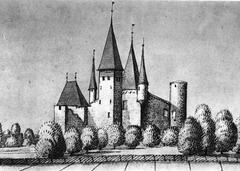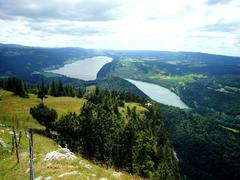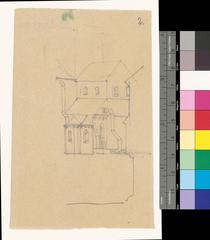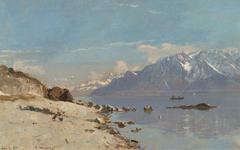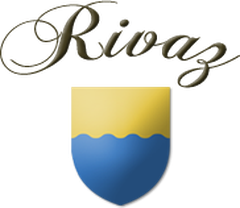Noviodunum Nyon: Visiting Hours, Tickets, and Historical Sites in Canton Vaud, Switzerland
Date: 03/07/2025
Introduction
Nestled on the picturesque shores of Lake Geneva in Canton Vaud, Switzerland, Noviodunum—modern-day Nyon—stands as a remarkable testament to Roman history and Swiss cultural heritage. Founded between 50 and 44 BCE by Julius Caesar as Colonia Iulia Equestris, this ancient Roman colony was strategically established to control the Helvetii and the Rhône Valley, settling retired Roman cavalry veterans. Today, Nyon invites visitors to explore its rich archaeological legacy, from the Roman Museum and amphitheater to iconic columns and medieval landmarks like Nyon Castle. This guide provides in-depth historical context, up-to-date visitor information, and practical tips to help travelers immerse themselves in one of Switzerland’s most captivating historical destinations.
For comprehensive details, museum hours, and archaeological insights, consult the Roman Museum of Nyon and the Nyon Tourism Website. Apps such as Audiala and Vaud:Guide offer interactive maps and virtual tours to further enrich your visit. (myswitzerland.com, archaeolist.com)
Table of Contents
- Introduction
- Roman Foundations and Early Development
- Strategic and Administrative Importance
- Crisis and Decline in Late Antiquity
- Medieval Transformation
- Modern Era and Heritage Preservation
- Main Attractions and What to See
- Practical Visitor Information
- Transportation and Access
- Best Times to Visit
- Tips for an Enjoyable Visit
- Events and Local Culture
- Frequently Asked Questions (FAQ)
- Conclusion and Recommendations
- Sources
Roman Foundations and Early Development
Nyon, originally known as Noviodunum, was founded as Colonia Iulia Equestris by Julius Caesar, designed to secure the region and reward Roman cavalry veterans. The city featured a classic Roman grid plan, with a central forum, basilica, and public amenities such as bathhouses and an amphitheater. At its height, Noviodunum was home to around 3,000 inhabitants, boasting advanced infrastructure including aqueducts and well-planned residential districts.
Strategic and Administrative Importance
Situated on the banks of Lake Geneva, Noviodunum served as a key administrative and economic hub, connecting Alpine passes with Roman Gaul. The city center held monumental structures, with the basilica now housing the Roman Museum. While initially unfortified, defensive architecture was gradually added in response to external threats in later centuries.
Crisis and Decline in Late Antiquity
The 3rd century brought significant challenges, notably through Alamanni invasions that damaged much of the city. Although Noviodunum was not immediately abandoned, its prominence waned in favor of Geneva. By the mid-5th century, only a small settlement remained, with the name evolving into modern “Nyon.”
Medieval Transformation
Following the end of Roman rule, Nyon became part of the Kingdom of Burgundy in 443 AD. The 12th-century construction of Nyon Castle signaled a resurgence, with the town serving as a regional center through successive Burgundian, Savoyard, and Bernese rule. The castle, now a museum, is a key landmark reflecting this layered history.
Modern Era and Heritage Preservation
Today, Nyon’s Roman and medieval sites are carefully preserved. The Roman Museum, the amphitheater, and the columns are complemented by national heritage sites like the Swiss Reformed Church of Notre-Dame. Extensive archaeological work ensures these treasures remain accessible to visitors and researchers alike.
Main Attractions and What to See
The Roman Columns and Esplanade des Marronniers
The three Roman columns, dating from 45 to 27 BCE, were relocated to the Esplanade des Marronniers in 1958 and now offer panoramic lake views. This scenic spot is free to visit and hosts summer concerts.
Roman Museum (Musée Romain de Nyon)
Housed in the restored basilica, the museum displays artifacts from Noviodunum, including mosaics, ceramics, jewelry, and architectural fragments.
- Hours: Tuesday to Sunday, 10:00–17:00. Closed on Mondays and some public holidays.
- Tickets: Adults CHF 8, reduced CHF 5, children under 18 free.
- Accessibility: The museum is fully wheelchair accessible.
- Guided Tours: Available by appointment and during peak seasons. (myswitzerland.com)
Nyon Castle (Château de Nyon)
Dating to the 12th century and overlooking the old town, the castle houses a porcelain museum and offers panoramic views.
- Hours: Tuesday to Sunday, 10:00–17:00 (April–October); weekends only in winter.
- Tickets: Adults CHF 10, seniors/students CHF 7, children under 16 free.
- Accessibility: Main areas accessible; some cobblestone sections may be challenging.
Château de Prangins
Five minutes from Nyon, this château features 18th-century exhibitions and the largest walled gardens in Switzerland.
- Hours: Tuesday to Sunday, 10:00–17:00. Closed Mondays.
- Tickets: Adults CHF 12, discounts for students/seniors, children free.
Amphitheater of Nyon
Discovered in 1996, this Roman amphitheater is open year-round and free to visit. Guided tours are available via the museum.
Musée du Léman
Dedicated to Lake Geneva’s environment and maritime history.
- Hours: Tuesday to Sunday, 10:00–18:00. Closed Mondays.
- Tickets: Adults CHF 10, children under 16 free; free entry on first Sunday monthly.
Old Town and Cobblestone Streets
Nyon’s old town features pastel buildings, lively cafés, and a Roman street grid. Self-guided tours are available through the Nyon Tourism App.
Lake Geneva Promenade and Wine Trails
Enjoy lakeside walks, water sports, and wine tastings along local vineyard trails. Many activities are free or low-cost.
Seasonal Events and Festivals
Nyon hosts events like the Paléo Festival (July), Visions du Réel film festival (April), and archaeological film festivals at the Roman Museum. Check the Nyon Tourism website for up-to-date listings.
Practical Visitor Information
Tickets and Booking
- On-site and Online: Tickets for museums and castles can be purchased on-site or online via official websites.
- Guided Tours: Book in advance for special access or group visits. English tours are available.
Accessibility
Major sites provide wheelchair access. Outdoor ruins and cobblestone streets may present uneven surfaces; assistance may be needed.
Transport
- By Train: 15 minutes from Geneva, 25 from Lausanne.
- By Car: Accessible via the A1 motorway; public parking is available.
- By Boat: Ferries from Geneva, Lausanne, and Yvoire (France) in summer.
- By Air: Geneva International Airport is 25 km away, with direct train connections.
Accommodation and Dining
Options range from boutique hotels with castle views to luxury stays in Lausanne. Dine in the old market area or lakeshore for Swiss specialties and local wines.
Visitor Facilities
Public restrooms, lockers at the train station, and free Wi-Fi at the tourist office and select public areas are available.
Best Times to Visit
- Spring to Autumn: Ideal for outdoor activities, festivals, and extended museum hours.
- Winter: Quieter, with shorter hours; the old town and lake views remain enchanting.
Tips for an Enjoyable Visit
- Language: French is primary, but English and German are widely spoken in tourist venues.
- Local Etiquette: Greet with “Bonjour” and respect local customs; tipping is not required but appreciated.
- Safety: Switzerland is safe, but keep valuables secure.
- Sustainability: Use public transport and refill water bottles at public fountains.
Events and Local Culture
- Paléo Festival: One of Europe’s largest open-air music festivals (July).
- Visions du Réel: International documentary film festival (April).
- Open-Air Concerts: Held on the Esplanade and lakeshore in summer.
Frequently Asked Questions (FAQ)
Q: What are the visiting hours for the Roman Museum?
A: Tuesday to Sunday, 10:00–17:00. Closed Mondays and select holidays.
Q: How much are tickets to Nyon’s main historical sites?
A: Roman Museum: CHF 8 adults, CHF 5 reduced, free for children under 18. Nyon Castle: CHF 10 adults, CHF 7 seniors/students, children under 16 free.
Q: Are guided tours available?
A: Yes, in English and French, bookable in advance.
Q: Is Nyon accessible for visitors with disabilities?
A: Most main sites are accessible, though some outdoor ruins have uneven ground.
Q: When is the best time to visit?
A: Spring through autumn for best weather and events; winter for a quieter experience.
Conclusion and Recommendations
Nyon, once Noviodunum, offers a unique journey through Roman, medieval, and modern Swiss history. Its well-preserved sites, engaging museums, and vibrant lakeside atmosphere make it a rewarding destination for all ages. For the best experience, plan ahead using official tourism websites, download the Audiala or Vaud:Guide app, and consider exploring nearby attractions like Château de Chillon and the Lavaux vineyards.
Start planning your visit today and experience where Swiss history lives—on the shores of Lake Geneva.
Sources and Further Reading
- Nyon Tourism
- Musée romain de Nyon
- MySwitzerland – Roman Museum and Amphitheater
- Archaeolist – Noviodunum
- Audiala – Nyon
- The World Pursuit – Switzerland Travel
- Affordable Tours – Switzerland in July
- Lonely Planet – Switzerland
- Happy to Wander – Switzerland Travel Tips
- Vaud:Guide App
- Swiss Archaeology
- Nyon Tourism App
Images:
- “Nyon Castle overlooking Lake Geneva”
- “Archaeological remains of Roman amphitheater in Nyon”
- “Scenic view of Lake Geneva promenade in Nyon”
(Images sourced from public domain or with permission)
